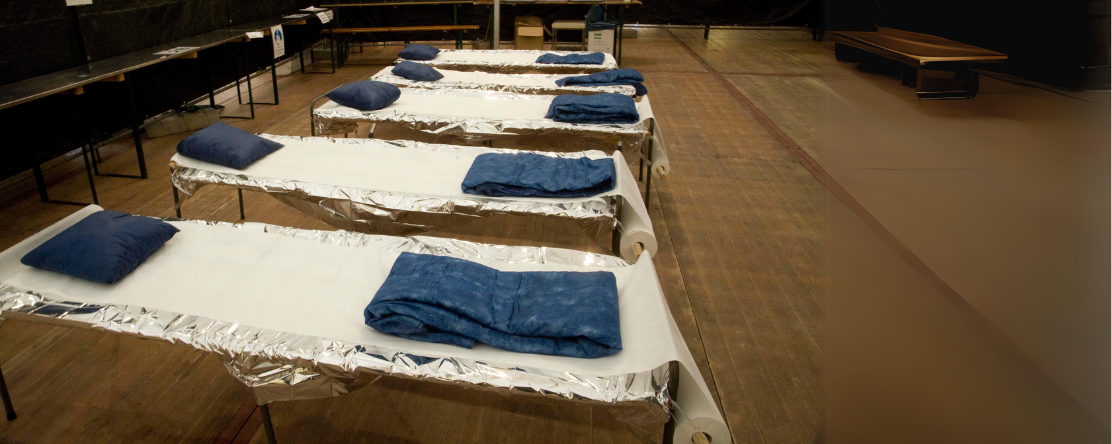
In the News
WaPo: PHI’s Mike Sage on How NFL Stadiums Can Operate as Disaster Shelters
- Washington Post

“As Hurricane Katrina ravaged Louisiana in 2005, more than 20,000 people sought a makeshift shelter in the Superdome, the home stadium of the New Orleans Saints.
Nearly two decades later, the Federal Emergency Management Agency and the NFL are partnering to turn football stadiums across the country into emergency shelters, temporary hospitals and other venues needed during disasters, according to details shared with The Washington Post. The initiative, which comes as Florida braces for a major hurricane, and floodwaters from Hurricane Francine soak Louisiana, aims to better prepare communities for catastrophic events.
Poor preparation and other problems have plagued past attempts to turn stadiums into shelters. New Orleans officials have said the Superdome, for instance, was intended as a refuge of “last resort” and lacked enough food, water and supplies to support thousands of people.
FEMA Administrator Deanne Criswell said in an interview that the new initiative will better prepare local officials so that they are not scrambling to respond to disasters as they unfold.
“The biggest difference between this and Hurricane Katrina is we’re doing this in advance,” she said. “We will know what the capabilities of each specific stadium are, and we will work with them on the threats in the cities that they’re in.”
Criswell noted that New York City — where she was the top emergency management official from 2019 to 2021 — used stadiums as temporary hospitals and vaccination sites during the coronavirus pandemic, helping spark the idea. The NFL approached FEMA with the idea nearly three years ago.
“It just made perfect sense,” said Criswell, who added that she hoped Major League Baseball and other sports leagues would follow suit. “We have all of these existing venues. How do we better coordinate during these blue sky days to better understand what they bring to the table and what we can use them for in the future?”
Cathy L. Lanier, chief security officer for the NFL and the former D.C. police chief, called the partnership “an obvious fit.” The two parties formalized the agreement by signing a memorandum of understanding on Tuesday at the NFL headquarters in New York City alongside Roger Goodell, the longtime NFL commissioner.
The stadiums would be available year round, according to FEMA director of public affairs Jaclyn Rothenberg, and the cost of operating these temporary shelters in the case of a federally declared disaster would be negotiated between local, state and federal government officials. The venues could be used for staging generators or for command-and-control centers, she added.
As climate change increases the severity of hurricanes, wildfires and floods, evacuating and sheltering thousands of people can pose major challenges for local governments, especially those with tight emergency management budgets. One of the greatest challenges is finding large spaces and hotels to house thousands of people — and then finding the funds to keep them there for weeks.
When Hurricane Ian slammed into Florida’s Lee County in 2022, for instance, residents had to drive for hours to find open hotels. Many had to stay in shelters for weeks, and Lee County had issues with staffing all of them. When Hurricane Laura lashed Louisiana in August 2020, disproportionately affecting Black and poor neighborhoods, dozens of people, including seniors, had to drive hundreds of miles to find refuge.
Disaster experts said that having NFL stadiums as spaces to store resources and use as emergency operations centers could help during extreme weather events. But there could be resistance to the idea, they said, and sheltering thousands of people for a week or more could be challenging.
“The emotional aspect and mental resistance of what we learned went on at the Superdome during Katrina could be a hard thing, especially in Florida and Louisiana, for people to overcome,” said Doug Quinn, CEO of United Survivors Disaster Relief. “There is still collective trauma of what happened there. How willing will people be to go to a shelter like that?”
Those who end up at shelters are often elderly, vulnerable, and people with lower incomes who have nowhere else to go, Quinn added, so ensuring those populations are safe could be a struggle.
Mike Sage, an emergency preparedness expert with the Public Health Institute, said providing privacy for proper hygiene could be hard. Individual tents, he added, could help.

If you just line up cots along the football field and you have thousands of people, that’s okay for a couple of days... But if it will be long term, you need to make it more comfortable.Mike Sage, MPH
Program Director, Regional Public Health Emergency Preparedness and Response: Region 9 Workplan, Public Health Institute
Sage added that it would be important to test stadiums’ capacity to operate during weather disasters, including whether they’re prepared “to provide electricity when all the electricity is down.”
Click on the link below to read the full article.
Originally published by Washington Post
More Updates
Work With Us
You change the world. We do the rest. Explore fiscal sponsorship at PHI.
Support Us
Together, we can accelerate our response to public health’s most critical issues.
Find Employment
Begin your career at the Public Health Institute.



